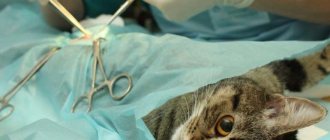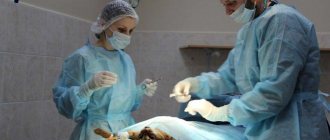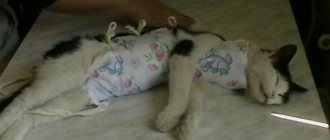Care
Do not be alarmed when, after the procedure, the veterinarian gives you a half-asleep animal in an almost unconscious state. The pet can remain in this form for up to a day - this is the effect of anesthesia. It is better to leave a sleeping cat on her favorite bed, but always on the floor. Gradually, the cat will begin to come to its senses, at first its coordination of movements will be impaired, and if it wakes up on a hill, for example, on a window, it can fall to the floor and get injured. By the way, it is not recommended to feed animals before surgery.
A mandatory rule in the postoperative period is rest and warmth. Under no circumstances should you leave a newly sterilized cat on the balcony or terrace - this can even lead to death. Make sure that the animal does not lick the wound area. If sterilization was carried out with an intradermal suture, then the cat does not need a blanket. If it was an external suture, then a special blanket is put on the animal, and after about 10 days the owner will have to visit the veterinarian again to have the sutures removed.
After surgery, every owner is required to change the pet’s diet. For example, for cats it is recommended to reduce the daily portion. The menu should be supplemented with fiber and boiled meat. If the owner prefers to feed his pet with special food, then it should be premium and super-premium products. It is recommended to consult a veterinarian regarding nutritional issues for a specific animal. The doctor will not only recommend the products of the most suitable manufacturer, but will also individually calculate the daily food intake.
See below for information on cat sterilization.
Why is the procedure needed?
Sterilization and castration are carried out to normalize hormonal levels in those pets whose sexual needs cannot be satisfied naturally. There are two types of indications for surgery: medical and behavioral.
An indication for surgery may be the behavior of the animal:
- the cat constantly marks the territory, after which a pungent smell of urine remains;
- the pet is aggressive, rushes at people;
- During estrus, the cat suffers, screams loudly, and cannot find a place for itself.
If it is not possible to regularly satisfy your pet’s sexual needs, then it is better to undergo surgery. After it, the animal will stop suffering from dissatisfaction and will become much calmer and more affectionate. After castration, cats stop marking, and their urine loses its pungent odor.
Medical indications are primarily related to the fact that hormonal imbalances can lead to many diseases in pets:
- Oncological diseases. Cats may develop cancer of the mammary glands, ovaries and other genital organs. In cats, prostate cancer comes to the fore.
- Pathology of the genitourinary system. This category includes urethritis, prostatitis and other inflammatory and infectious diseases. In addition, it has been scientifically proven that this surgical intervention increases the pet’s life expectancy.
- Stop marking the territory;
- Disappearance of the too strong smell of urine;
- Lack of desire to run away from home;
- Stopping aggressive behavior and maintaining a playful nature;
- Increased life expectancy;
- Prevention of prostatitis, prostate tumors, etc.
- Administration of anesthesia (intravenously, often intramuscularly);
- Preparation of the “operation field”;
- Making two or one small incisions in the skin of the scrotum;
- Ligation of the spermatic cords;
- Removal of testes;
- Treating the stump with antiseptics;
- Administration of standard medications (antibiotic, hemostatic).
The operation does not require stitches and is carried out very quickly. The entire procedure will take 15 minutes.
You can choose the option of castration, when the cat sleeps for 3-4 hours (classic option of castration). At the same time, the cat should not eat on this day, and water can be given only 5 hours after the doctor leaves.
There is a more pleasant option of castration, when the cat comes to his senses already in front of the doctor and even goes to accompany the doctor to the doorstep, controlling his body quite well (which is excluded in the classic version). In this option, you are allowed to eat after 2 hours and drink immediately.
If you wish, you can purchase a cat collar from the doctor, which can be worn for the first 2-3 days to prevent the cat from licking the wound.
Immediately after castration, the food does not change, and the cat eats as before, with its usual food. It is recommended to switch to castrated food 3-4 weeks after neutering. When feeding castrated cats, you should follow a special diet that excludes the consumption of fish dishes.
What types of operations are there?
Now let's define the terms. In fact, the term “sterilization” is not always correct. Sterilization (oophorectomy) is the removal of only the ovaries, which has hardly been practiced in recent years. Castration (ovariohysterectomy) is the removal of the ovaries and uterus. But nevertheless, even many veterinarians use the term “sterilization”, meaning castration, because. clients are accustomed to this formulation. In this article, we also use these two words as synonyms for convenience.
We suggest you familiarize yourself with: Male age for mating
There is another type of sterilization - tubal ligation (tubal occlusion) or removal of the uterus while preserving the ovaries (hysterectomy). After this procedure, the cat remains in heat, that is, she continues to attract males, but cannot conceive. With this approach, the cat continues to have empty heats, which will most likely result in an inflammatory or cancerous disease sooner or later.
But nevertheless, occasionally owners perform this particular operation. Why? It is needed if there is a cat and a breeding cat living in the house, which does not mate every day to produce high-quality offspring, but there is a need for sexual intercourse. Then the cat living next to him, whose pregnancy is unwanted, has her tubes tied, as a result of which, during the breaks between participation in breeding matings, the cat can have sex with her without any consequences, and thus keeps himself in shape.
In all other cases, veterinarians advise performing either oophorectomy (removal of the ovaries) or immediate ovariohysterectomy (removal of the ovaries and uterus). Many veterinary clinics have left only the second method in their price lists, because it is preferable: if only the ovaries are removed, the risk of developing cancer and inflammatory diseases of the uterus remains. Then the operation has to be done again, but with a greater likelihood of a negative outcome.
All of the above types of operations can be performed using two methods, which differ in the method of penetration into the abdominal cavity.
Laparoscopy is a surgical operation under general anesthesia, in which penetration into the abdominal cavity occurs through tiny incisions (usually 2-3 with a diameter of 3 to 10 mm each), introducing a special instrument with a camera into the incisions, which displays an image on the screen and allows operation without visual access of the doctor to the insides.
Traditional abdominal surgery (laparotomy) is an operation with full visual access of the surgeon to all the internal organs of the cat, without any cameras or screens. It is more traumatic, as it involves one incision from 2 to 10 cm. After it, a long rehabilitation period (10-14 days) is required with stitches and wearing a blanket. This is the type of operation that is most often practiced and is considered a classic method. In contrast, laparoscopy is a newfangled, expensive method.
If you're not afraid of technical details, you can watch a training video for surgeons on how to perform surgery on a cat. It contains a lot of details that are unnecessary for the average person, but you will become familiar with the process in great detail.
Laparoscopy for cats began to be performed relatively recently, so this operation is not available in all clinics. And it costs several times more. In addition, it is not certain that your veterinarian has the necessary experience. Therefore, in conditions of limited choice in small towns, it is always better to opt for the operation that specific doctors in the veterinary clinic can perform masterfully.
At what age?
If the question of the operation can be considered resolved, it is very important not to miss the moment and do it on time. Now there are no strict limits on this, and in clinics where sterilization is routine, cats can be accepted from the age of three months
However, no one is saying that early intervention is impossible. But the consequences may not be entirely good. For lovers of purebred cats, their appearance is important.
Typically, cats are sterilized when their body has developed and become strong enough. In addition to cosmetic disadvantages, this makes it easier to endure the operation itself and to recover better after it. The optimal age is from 8 to 11 months. In addition, it is necessary to contact a veterinarian before the cat begins to mark its territory or at the first manifestations. It is believed that the earlier a Scot began to do this, the more likely it is that he will continue this at an older age. The percentage of such cases is small, but it exists. The same goes for cats - it’s better to do it before she has time to get to know the cat better.
Sometimes sterilization is necessary for adult animals, especially if there are health problems. But there are pitfalls here too.
Features of preparation and care after
Both castration and sterilization are elective surgeries, so the animal must be examined by a doctor before setting a date. It is best to ask your veterinarian for all the information about upcoming procedures.
Particular attention should be paid to preparing for surgery. This Scotsman must be examined by a veterinarian to make sure he is healthy
Therefore, it is necessary to start small: rid him of fleas and parasites, get all the necessary vaccinations in advance (at least a month before the operation). Contraindications are diseases in the acute phase, as well as the cat’s estrus period. As for hygiene, everything is very simple.
It is advisable to trim the claws and wash the animal. But if a Scot doesn’t like to swim, this needs to be done at least a week in advance. This and other stressful situations should be eliminated in the coming days so that the cat feels calm.
Immediately on the day of surgery, the animal should not be given food, medications or supplements without the consent of the veterinarian. All procedures usually do not take more than an hour, after which the pet can be picked up. But since it is believed that Scots, like other purebred cats, react poorly to anesthesia, it is better to spend the next two to three hours in the clinic. Moreover, the pet may need help for several days, so it needs to be well looked after.
Immediate recovery from anesthesia can last up to a day. Therefore, during this period it is necessary to eliminate all dangers that the cat may encounter. It should not be placed on high surfaces for fear of falling, or left unattended near a container of water due to the risk of unconsciousness and drowning. To keep your cat from freezing, you need to wrap it up and monitor the temperature in the room.
The seams deserve special attention. Cats may need a blanket, depending on the complexity of the operation (removal of only the ovaries or along with the uterus). You can remove the blanket only after visiting the veterinarian again. In cats, stitches may not be needed during sterilization. But you need to make sure that it does not disturb the operation site. The condition of the seams can only be assessed by a specialist. He can also prescribe medications and give other recommendations that must be followed.
Food deserves special attention. In the first days, preference should be given to wet food so that constipation and other problems do not cause additional discomfort. Then you need to switch to special food.
For information on sterilizing a Scottish cat, watch the following video.
How to prepare for surgery?
Let's start with the conditions under which a cat cannot be sterilized. This cannot be done for up to 6 months, although there are craftsmen who do this. This should not be done on old cats over 10 years old. Cats that are over 5 years old and have not been properly examined prior to surgery should not be neutered.
Let's take a special look at sterilizing a cat during estrus. This is also strictly prohibited. As a veterinarian consulting for the MURKOTIKI website explained, during a cat’s heat, the genitals become engorged with blood, and if she is cut during this period, there is a risk of complications caused by blood loss. Several days should pass from the end of estrus.
Moreover, the end of estrus is not considered from the moment when the cat fell silent and returned to normal behavior: after this, for about another 5-7 days, estrus can continue in a manner invisible to humans, so a cat can be sterilized no earlier than 10 days after the visible end of estrus with the human eye.
And now directly about what needs to be done before the operation.
- If your cat has fleas or worms, they need to be removed.
- It is advisable to trim the claws so that the cat does not injure itself during the postoperative period.
- If vaccination is carried out before surgery, this should be done no earlier than three weeks before sterilization.
- 2 weeks before and 3 weeks after surgery, the cat should not be bathed, so as not to expose the body to even greater stress.
- Before the operation, the cat must be perfectly healthy, and if she is over 5 years old, additional studies related to the functioning of the heart and other organs may be needed to prove her health.
- It is better to do the operation in the morning and provide the cat with a carer that day.
- The cat should not be fed 8-12 hours before surgery (your veterinarian will determine the specific number).
- No medications should be given to a cat without the knowledge of the veterinarian. They can disrupt nerve reactions or blood clotting - and the cat can die on the operating table.
We invite you to familiarize yourself with: Breeds of geese (51 photos): meat species with names, black, Italian, Tula breeds with descriptions, features of breeding at home
When are Scottish cats neutered?
Sterilization of Scottish cats: Scottish Folds, Scottish Straights, Highland Folds and Highland Straights is carried out at the moment of puberty, which greatly affects the further development of the animal. It matters whether the age at which the operation is performed is too early or too late. Veterinarians consider the optimal development of a Scottish cat for sterilization to be approximately 10-12 months, this is due to the fact that:
The young pet has already grown up enough, is hormonally mature, is able to withstand surgery without complications, and can easily tolerate anesthesia. It speeds up the healing process of skin tissue, which reduces the possibility of infections.
At a more mature age, up to 5 years, postoperative complications and a poor reaction to anesthesia may occur during sterilization. Long-term healing of postoperative suture.
If the cat has had sexual intercourse, then after surgery and removal of the ovaries, she will not be able to give birth, but will retain the function of producing hormones from the pituitary gland and will continue to reproduce in estrus.
Experienced breeders and veterinarians know that sterilization extends the life of a cat to 4 years, which can be explained by the fact that during frequent births a cat loses strength and health to bear kittens, and does not have enough time to recover.
It is difficult to select a purebred Scottish pair, when the fold-eared ones mate - Scottish Folds, Highland Folds with the straight-eared ones - Highland Straights, Scottish Straights. Mating with individuals of other breeds is prohibited; it leads to the birth of out-of-breed kittens. Unfortunately, they often fall into the category of stray animals. Their number will help to reduce castration and street cats as well.
The cost of sterilizing Scottish cats is much higher in the central cities of the Russian Federation, and the price also increases when calling a veterinarian to perform the operation at home. This is convenient for the owner, but more for the pet:
- Moving is always stressful for an animal;
- At home, she will more easily survive post-operative anesthesia;
- In a weakened state, you cannot catch an infection.
Table No. 2: Approximate cost of sterilization of cats in different cities of the Russian Federation
Why is a cat sterilized?
Despite the severity of abdominal sterilization surgery for a Scottish cat, most veterinarians advise performing a medical procedure during puberty that will free the animal from emotional suffering during estrus. Sterilization is especially necessary for Scottish fold cats: Scottish Fold, Highland Fold, mating, which are prohibited due to genetic abnormalities.
The use of special medications temporarily helps, but does not relieve the cat from repeated heats when the dissatisfied animal accumulates surges of hormones. A constant increased accumulation of them in the organs can lead to serious diseases and shorten the life of the pet.
Abdominal surgery is performed under anesthesia, but the cat’s young body can handle it and in 10-14 days, with proper care, the wound will heal.
The operation itself, which allows you to sterilize a cat, is called ovariotomy, and involves removing the ovaries. A more modern method is castration, or ovariohysterectomy, in which not only the ovaries are removed, but also the uterus itself.
Pet after sterilization
After laparoscopy, which is considered a more modern operation, minimally invasive, low-traumatic, the recovery period is shortened, small wounds, fastened with self-absorbable threads, heal quickly with minor treatment.
Scottish cats after sterilization
The Scottish Fold cat after sterilization is no different in condition from the average straight-eared cat. After the operation is completed, which can take from 20 to 40 minutes, the cat is returned to the owners after checking its condition. Sometimes owners are asked to come pick up their cat in 3 hours. This happens if in this clinic the cat is monitored after surgery. There is no need to refuse such an offer. And even vice versa, if it is possible to order a service for the rehabilitation of a cat after surgery within 3-4 hours, do it. Coming out of anesthesia is a difficult moment, which ideally should take place under the supervision of specialists in a veterinary clinic. In the right medical centers, veterinarians themselves will not give you an unconscious animal.
It is advisable that you buy a comfortable carrier to transport your cat home. You need to travel in your own car or by taxi, and under no circumstances use public transport.
The cat will recover from anesthesia for some time, even if it was given to you already conscious. Some people need only a few hours to get into an adequate state, while others need a whole day. It all depends on the type and dose of anesthesia, the cat’s body and other factors.
The cat cannot be placed on the bed after surgery, as it may fall. Place only on the floor: of course, on a warm mat. Make sure your cat doesn't freeze. Wrap her in a blanket, avoid drafts. In the meantime, while she is under anesthesia (if you are given an unconscious animal), touch the bedding all the time: the cat may have peed itself, then you need to change the diaper. If the cat lies in the wet, it will become hypothermic and get sick. You can buy an absorbent diaper at the pet store in advance to train puppies to the toilet. It absorbs moisture well and is easily replaced with another.
When the cat wakes up and starts walking around the apartment, you will need to insure it, because... She doesn't understand that you can't jump with stitches. In addition, at first she will not be entirely adequate and may not be able to orient herself in space at all, even to the point of trying to walk backwards. Here's how it happens: in the next video, a fold-eared cat is recovering from surgery.
After the operation, the pet cannot be fed on the same day. Exceptions are those cases when the veterinarian has given the go-ahead. It is better to feed the next day. Giving dry food during the postoperative period is prohibited, because constipation should not be allowed: constipation causes the cat to strain and the stitches may come apart. If constipation still takes you by surprise, you should give the cat condensed milk (it weakens the intestines) or inject Vaseline into the throat with a syringe (it facilitates the passage of feces).
The doctor may also prescribe prophylactic antibiotic injections to prevent sepsis, special substances for treating the wound, if necessary, as well as painkillers. You can do the injections yourself, or you can take your cat to the clinic or call a veterinarian at home.
An important point: no matter how much it may seem to you that the blanket is no longer needed, you cannot remove it. Cats perceive the threads used to sew them up as something foreign and try to pull them out. As a result, the seam will come apart, and it will be very difficult to heal again.
After traditional surgery, sutures are removed for cats at approximately 10-14 days. During laparoscopy, there is no need to remove sutures; they dissolve on their own.
If you decide to sterilize your pet, read more about caring for your cat after sterilization.
Cat in a blanket after surgery
Preparing a cat for sterilization
The process of preparing for the operation is taken with the utmost seriousness, because general anesthesia is used.
Be sure to follow all the recommendations of the veterinarian!
Before surgery, tests and ultrasound may be prescribed, and a visit to a cardiologist and therapist is recommended.
Such precautions serve to ensure the safety of the animal and the doctor’s confidence in the absence of unpleasant surprises during work. Such precautions are relevant for cats over 10 years of age due to possible pathologies of internal organs.
Before sterilization, the cat should not eat for 8 to 12 hours, and 3 hours before the operation the animal is not allowed to drink, otherwise severe vomiting will occur during the induction of anesthesia. Vomit easily enters the respiratory tract, introducing various types of bacteria.
For everything to go well, you must comply with all the requirements for preparing your pet for anesthesia.
How is a cat sterilized?
At the client's request, a good clinic will offer premedication - preliminary medical preparation of the body for anesthesia and surgery. After this, anesthesia is administered intramuscularly or intravenously. Under anesthesia, a cat's eyes are open, so they will need periodic wetting with a special preparation to prevent drying out.
Already under anesthesia, the veterinarian shaves the cat's belly hair and makes a skin incision below the navel in the case of traditional surgery. In the case of laparoscopy, small incisions are made. After this, the genitals (uterus and ovaries) are removed. In a traditional operation, the surgeon does this by seeing the organs with his own eyes directly in the section. During laparoscopy, he sees the organs on the screen, and at this time they are in the abdominal cavity.
At the end of the operation, stitches are applied. There are sutures that need to be removed after 10 days, and there are self-absorbing ones. In the case of a traditional operation, after suturing the cat, a blanket is put on the cat; in the case of laparoscopy, there is no such need.
Age and features
It is very important to spay and neuter at the right age. There are two factors associated with this:
- Carrying out the procedure too early can lead to inhibition of the pet’s overall development, since sex hormones at an early age affect the body’s growth process;
- Carrying out surgery too late in cats may not eliminate the habit of marking territory, and in cats it may result in the symptoms of estrus not disappearing.
Thus, on the one hand, the operation should not be performed too early, and on the other hand, it should not be delayed either.
Now let's find out how to determine how many months or years a pet must be in order to undergo castration or sterilization.
Castration of cats
The ideal age at which to castrate a cat is considered to be between 10 and 12 months. At this age, the Scottish Fold has already reached puberty, that is, eliminating the action of sex hormones will not affect his overall health. And at the same time, he has not yet acquired the habit of marking his territory.
In cases where it is not possible to perform surgery during the specified period (most often this is due to the pet’s health), castration can be performed at an older age. But it is strictly not recommended to carry out surgical intervention earlier. This is associated with the risk of disproportionate physical development of the cat.
Sterilization of cats
It is also best to sterilize Scottish Fold and Straight-eared cats before they are one year old. At the age of 10–12 months, the cat has already developed physically and has enough strength to undergo surgery with minimal risk of complications.
If sterilization is carried out at a later age, adverse consequences may develop:
- Firstly, if the operation is performed after sexual intercourse, the pituitary gland takes over the function of the ovaries in producing hormones. In this case, even after sterilization, there is a possibility that the hormonal balance will still be disrupted.
- Secondly, sterilization at a later age is associated with an increased risk of postoperative complications. A cat tolerates surgery much easier at a young age, when skin regeneration occurs faster and the risk of infectious complications is lower.
Minimizing damage
If sterilization is unavoidable, it is necessary to minimize the negative consequences of the operation for the animal. To do this you need:
- Find a good specialist and a reputable clinic where it is possible to monitor the progress of the operation and provide inpatient care for the animal until recovery;
- Choose the time: the optimal age for sterilization of Scottish fold cats is 9-10 months; with an earlier operation, the cat’s body will not complete its formation and developmental deviations may be observed; if it is later, the risks increase in proportion to age;
- Consider post-operative care issues and make an appointment at the veterinary clinic.
There is no consensus among experts on whether an animal should be bred before sterilization. Some believe that this is correct - if you castrate a cat before the first mating, they will never fully mature. Supporters of early operations argue that after mating, sterilization does not necessarily lead to complete freedom from sexual estrus. It's up to the owner to decide, of course. It is worth keeping in mind that sterilization is not the only option. There are hormonal medications for animals that can significantly reduce the anxiety of “critical” days.
Are Scottish cats sterilized?
- Yes. Of course, they are sterilized, just like cats of other breeds. If you do not plan to become a professional breeder, sterilization is something you should think about first.
Physically and psychologically, it is very difficult for cats to endure periods of “binge,” and since this happens several times a year and if the cat does not communicate with cats and pregnancy does not occur, a layer of hormonal levels occurs in its body, which can cause serious illnesses and even cancer. Therefore, by sterilizing a cat, you not only rid yourself of unwanted manifestations of its behavior, but also take care of its health; from this point of view, sterilization of Scottish cats is more than justified.
Choosing the right doctor is half the battle
No matter how simple the castration procedure may seem, it must be carried out by a competent doctor. The Good Doctor veterinary clinic in Moscow has at its disposal everything you need for safe castration:
- We employ only qualified doctors;
- a full set of diagnostic equipment;
- possibility of observing the animal in a hospital.
If necessary, we can offer a doctor to visit your home in Moscow and the Moscow region. The cost of castration of a fold-eared cat depends on the state of his health. The price of castration or sterilization of a Scottish cat also depends on the method of operation. Check prices when visiting the clinic: final and complete information can only be obtained after examining the animal.
Types of cat sterilization
There are several ways to perform the operation: chemical and surgical.
- Tubal occlusion: The cat's fallopian tubes are ligated, eliminating the possibility of pregnancy. Although the intervention is surgical, the reproductive organs are not removed.
- Sterilization is classic - along the white line of the abdomen or an alternative option: through a side incision. In this case, the incision is made on the side, and the muscles are separated using a blunt method. Although the method is less traumatic than the previous one, the uterus is not always completely removed. No seam maintenance is required. An intradermal suture allows the cat to immediately resume its usual lifestyle, gradually restoring its health.
- Sterilization through a very small incision using a surgical hook. A synonym is laparoscopic sterilization, which is not entirely correct, since the peritoneum and skin are also cut, but with a much smaller incision along the length. A disinfected hook is inserted into the wound and used to hook the ligament to the ovary. A ligature is applied and the ovary with a ligament or the entire uterus is removed.
- Laparoscopy as sterilization (ecdoscopic): Thanks to endoscopic technologies, punctures are made in the skin of the abdominal wall and the uterus and ovaries are completely removed. Expensive equipment is used, so the cost of the operation remains high.
- Chemical method or temporary sterilization: a special implant containing a drug is inserted under the animal’s skin. The substance gradually enters the bloodstream and the cat develops a reversible sterilization effect for up to three years.
They choose the appropriate method responsibly: they study veterinary clinics and reviews of them from professional breeders. Saving money and haste are bad advisors in this matter.
Castration of a cat
If during sterilization, which is also called oophorectomy (OE), the ovaries are surgically removed, then during castration both the ovaries and the uterus are removed. Such intervention in the body can be planned or according to indications. There are no contraindications for castration based on the age of the cat.
How is laparoscopic sterilization performed?
After putting the animal under anesthesia, an incision of about 1 cm is made in order to insert a hook into the abdominal cavity. This device moves the intestinal loops and picks up the uterine horn. The uterus along with the ovaries are pulled out through a tiny wound.
This is possible due to the elasticity of cat tissues, especially at a young age.
Then the pulled out organs are strongly pulled out to apply a ligature to the arteries of the ovaries and ligaments, as well as to the horns of the uterus. The process of stretching is very serious, because in fact it is on the verge of breaking the ovarian ligament.
The uterus is cut off and removed, the centimeter incision is sutured: such a seam is not processed or covered with a blanket, since the cat will not be able to lick it.
Essence of the operation
Castration is the complete removal of reproductive organs. When castrating cats, their testicles are removed. This operation is simple and is generally tolerated by animals normally.
Castrating a cat is more difficult - penetration into the abdominal cavity is required. There are several methods of surgery, each with its own advantages. We advise you to choose the one that your doctor knows best.
Sterilization is the partial removal of reproductive organs, practiced in females, and consists of cutting out the ovaries. The uterus remains. Currently, it is recommended to castrate cats too, since the uterus, being unable to function normally in the absence of ovaries, becomes a target for various diseases.
Advantages and disadvantages
The following facts will help the owner decide to undergo surgery for his pet.
- As already noted, sterilization and castration of cats significantly reduces the risk of developing serious pathologies of the genitourinary system.
- It has been proven that sterilized cats live longer than those that have given birth. The fact is that during childbirth the animal loses its health and strength, because a cat has to give birth several times a year, and the average life expectancy of Scottish Folds is 10–14 years. Sterilization can prolong a cat's life by 3-4 years.
- The risk of losing your pet is reduced. Now the animal that nature calls outside will not wait near the door for the right moment to escape. This is especially true for residents of upper floors. Often cats, in search of a partner, escape through windows and balconies, and this can be dangerous to their life and health.
- If a partner of a suitable breed is not found for a Scottish Fold pet, then you will have to breed the pet with a representative of unsuitable blood. This leads to offspring that have no value. It will be difficult to sell or give away kittens; outbred kittens often end up on the street. Sterilization will reduce the number of stray animals.
Before enrolling an animal in a veterinary clinic for castration or sterilization, it is worth considering some of the risks that this procedure carries.
- After surgery, animals, especially cats, begin to quickly gain weight due to hormonal reasons. Choosing food for a neutered cat requires a serious approach. To maintain the health of the animal, you have to buy expensive feed.
- During sterilization, the cat is given anesthesia. If the animal has heart problems, it may not tolerate the effects of anesthesia. Therefore, a full medical examination is required before the procedure.
- If an external suture is used during sterilization, the cat should be blanketed for the next few days. The owner needs to ensure that the pet does not get caught in the bandages, remove the blanket or lick the seams.
Postoperative care rules
Care of the wound surface in cats is not required. However, you need to ensure that your pet does not lick the wound area. If sterilization in cats was carried out laparotomically, then the sutures need to be treated from the second day. For this, antiseptic solutions and ointments are used to improve regeneration.
The main negative consequence for a pet after castration is obesity. Therefore, sooner or later the question arises of what to feed a neutered Scottish cat:
- If the pet was on a natural diet, then it is necessary to review the diet. First of all, you need to determine your daily calorie intake. After castration, it is recommended to slightly reduce the portion. If previously the norm was calculated using the formula 80 kcal per 1 kg, then after castration the caloric intake decreases: 60–70 kcal per 1 kg. In addition, add more fiber to your diet in the form of vegetables, as well as boiled meat. Also eliminate milk from your diet.
- If the cat has been eating dry food, it is better to change it to a special product for neutered animals. Such foods have a balanced composition and are also aimed at preventing urolithiasis. For example, Vet Care Nutrition from Royal Canin (premium food) or Proplan food labeled Sterilized.
Features of sterilization of British and Scottish breeds
Experts recommend sterilizing British and Scottish cats between the ages of 8 and 12 months. This is due to the fact that at this age the animal reaches puberty, and the body is sufficiently developed to normally withstand the operation and undergo anesthesia.
In addition, British and Scottish women mature a little later than their relatives, but sterilization in the early period avoids the psychological factor. Cats after removal of the uterus and appendages may begin to show signs of sexual heat. This is due to the fact that after removal of the genital organs, the pituitary gland can completely take over the function of producing hormones. Therefore, if sterilization is not timely, the owner may not get rid of the cat’s annoying behavior.
Particular attention must be paid to the nutrition of these breeds. They have a predisposition to large weight gain, and after surgery, obesity in these cats occurs very quickly. In order to avoid obesity in a cat, it is recommended to consult with a veterinarian on the preparation of the correct diet, as well as to ensure as much active exercise as possible so that the animal uses up reserves energy
When purchasing a kitten or an adult, the owner must determine a goal for himself. The cat can be purchased for further breeding and offspring. In such cases, you need to understand the responsibility for the fate of the kittens when they are born and grow up.
In another case, a cat is purchased simply to become a loyal friend and pet, and expecting offspring is not included in the plans. It is recommended to immediately ensure that the cat is sterilized, because by using medications and contraceptives for animals, the owner dooms the animal to torment and suffering. Often the consequence of the use of drugs that reduce sexual desire is the development of dangerous diseases and death.
Sterilization: pros and cons
If we are talking about a voluntary decision, we advise you to think again: sexual instincts form a significant part of the animal’s personality, and you will lose something in communicating with him due to sterilization.
The “advantages” of sterilization include:
- cessation of sexual function and its external manifestations: no unpleasant odor, no noise;
- sterilization has a rather beneficial effect on obstinate pets - they become calmer and more self-possessed;
- no need to worry about the fate of the offspring.
Particular attention should be paid to the issue of operations on purebred animals, in particular – sterilization of Scottish cats and Manx cats. These cats have specific problems with skeletal development, which explains their characteristic folded ears. If improperly bred (outside a nursery), they can have serious problems with the musculoskeletal system.
Crossing fold-eared and tailless cats with each other (within the breed) is strictly unacceptable. They are usually crossed with the British cat. The offspring of these animals are valuable only if they have documents. If you do not plan to breed Scots, it is better to sterilize them.
Disadvantages of sterilization:
- like any surgical intervention, sterilization of cats has risks, albeit minor ones;
- It will be impossible to restore reproductive function to the animal.
What vaccinations are given to kittens, cost
Small, helpless kittens receive the first antibodies that increase immunity along with the mother's cat's milk. After weaning, instead of colostrum, the baby needs additional protection of the body from viruses and bacteria. At the age of 8-10 weeks, vaccinations are required for Scottish kittens. Before the first vaccinations are carried out, the kitten is prepared and the body is prevented from worms.
Depending on the conditions of detention and lifestyle, the first vaccination for a Scot contains:
- a vaccine against herpesvirus, calicivirus, panleukopenia and rabies, even if the animal leads a permanent home lifestyle;
- They also vaccinate against viral leukemia and chlamydia if the kitten lives in a private house, in a country house and leaves the house where it has likely contact with other animals;
Vaccinations for fold-eared kittens, as well as straight-eared Scots, are performed in accordance with the following scheme:
- At 2 months, the full range of vaccinations with the exception of the rabies vaccine;
- At 3 months, revaccination is carried out with the same complex of drugs with the addition of rabies vaccine.
- Every year and beyond, as the child grows, the entire vaccination package is repeated, including the anti-rabies drug.
The cost of vaccination depends on the price of the drug and factors of the procedure in different regions of the country and consists of:
- from the cost of the most common complex of drugs: Purevax RCPCh + Rabizin + Nobivac Rabies;
- prices for issuing a veterinary passport;
- payment for the work of a veterinarian;
- payment for calling a doctor to your home.
Adults (what vaccinations are given to adults + cost)
Vaccinations for adult cats and Scottish cats have the following advantages:
- they support the immunity of animals to environmental living conditions.
- Vaccinated pets develop a persistent, throughout the year, resistance to serious diseases;
- The vaccinated animal is protected itself and the owner is guaranteed protection, for example, from rabies;
- The occurrence of some infectious processes in a mild form
- When walking in nature and interacting with other animals, the risk of your pet contracting an infection is reduced to a minimum.
Throughout life, the vaccination procedure is repeated annually, preferably in the same month of the year. They make sure that the animal is dewormed on time, is healthy, and that the cat is not pregnant or nursing cubs.
The basic composition and cost are similar to vaccination for kittens, depending on the region and other factors.
Best age for sterilization
The period of puberty in cats differs from other pets. Once a cat reaches 6-9 months of age, it is considered fully sexually mature and can bear viable offspring.
In some cat breeds, due to the characteristics of the body, puberty occurs slightly earlier - at the age of 4.5 - 6 months. This period is characterized by the active release of hormonal substances of the sexual type into the bloodstream - estrogens (produced by the ovaries). Under the influence of a specific hormone, a condition arises that the cat causes anxiety to its owner - it begins to scream heart-rendingly and demand a male, trying to escape from the house.
Depending on the breed and temperament of the animal, the period of increased activity ranges from 2-3 days to 2 weeks. The period is marked by the fact that all organs of the reproductive system are actively preparing for the normal process of conception and further gestation of attached embryos. If the cat does not happen, then the body begins to produce another hormone - progesterone, which is responsible for reducing heat.
Often, animal owners resort to using various tablets and drops that limit the release of hormones in the body, thereby preventing the onset of estrus. Subsequently, pathological conditions such as endometritis, pyometritis, cystic hyperplasia of the uterine walls, and cystic formations on the ovaries arise. You can protect your cat by promptly sterilizing it.
The best age for sterilization is before the first heat. This is the age when the kitten has already reached puberty, but the reproduction process has not yet started. In most cases, the average age at which it is better to sterilize is 6-9 months
It is important to remember that if a cat has already begun to come into heat, you must try to prevent conception.
At what age should a cat be spayed?
In this case, sterilization can be carried out 7-10 days after the end of the mating season. To determine at what age sterilization can be performed, a qualified veterinarian must take into account all the parameters of the animal - developmental state, health indicators, presence of vaccinations. Like any other surgical intervention, castration of animals has a number of its positive and negative aspects.
After the operation, the cat becomes more domestic and attached to the owner, sociable with people and is not subject to sexual instincts in order to escape from home. In addition, the risk of developing various diseases is reduced. An indisputable fact is that after sterilization, the animal becomes a long-liver, due to the reduction in the risk of inflammatory processes in the uterus and appendages.
In addition to the pros, there are also cons. These include changes in metabolic processes in the body, and the risk of obesity also increases. The consequences of an incorrectly selected diet after sterilization are:
- urolethiasis;
- allergic reactions;
- diseases of the cardiovascular system;
- kidney disease (urolithiasis).
Note! It is not recommended to abruptly change the diet or put your cat on a strict diet after castration. The fact is that a sharp decrease in the animal’s weight can lead to the development of a dangerous condition – lipidosis of the liver structures.
Early sterilization
Some doctors argue that sterilization carried out before puberty will help prevent possible disturbances in the functioning of the body. The optimal age for such sterilization is from 3 months to six months . The organs are quite well developed at this age, which allows a specialist to carry out manipulations without any problems.
It is important to remember that if a cat is sterilized too early and has not reached puberty, irreversible changes begin to develop in the body - hormonal imbalance.
Uncontrollable behavior and unexpected states of the cat may appear. The fact is that the development of the reproductive sphere is closely intertwined with the work of the hypothalamus, which is responsible for the behavior of the animal.











